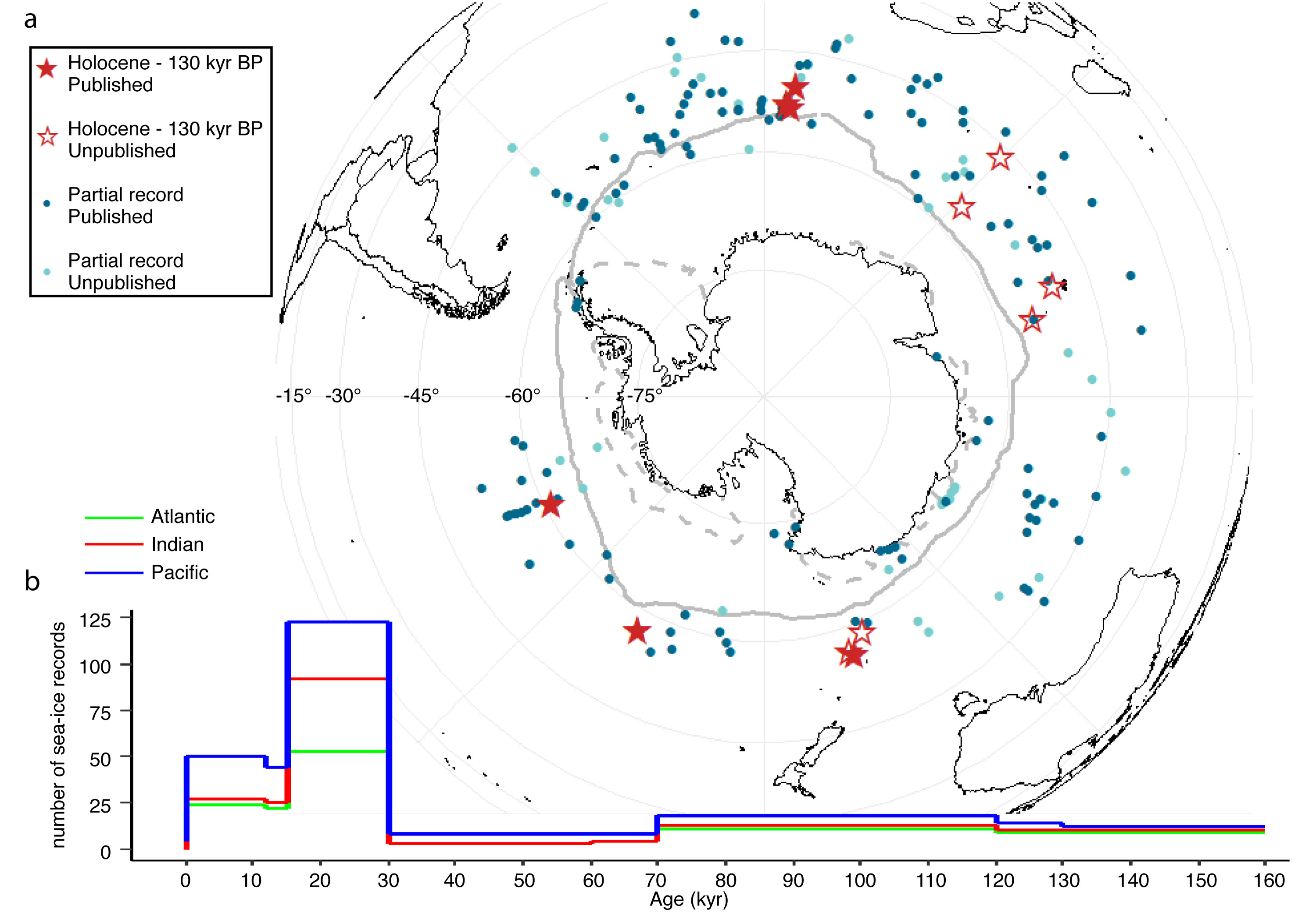- Home
- Publications
- PAGES Magazine
- Understanding Glacial-interglacial Changes In Southern Ocean Sea Ice
Understanding glacial-interglacial changes in Southern Ocean sea ice
Chadwick M, Jones J, Lawler K-A, Prebble J, Kohfeld KE & Crosta X
Past Global Changes Magazine
27(2)
86
2019
Matthew Chadwick1,2, J. Jones3, K.-A. Lawler4, J. Prebble5, K.E. Kohfeld3 and X. Crosta6
2nd C-SIDE workshop, Sydney, Australia, 29 August–1 September 2019
The Cycles of Sea-Ice Dynamics in the Earth System working group (C-SIDE; pastglobalchanges.org/c-side) conducted its second three-day workshop which brought together 35 participants from 24 institutions in 12 countries. Following the success of the first workshop (doi.org/10.22498/pages.27.1.31), the C-SIDE working group used the second workshop (pastglobalchanges.org/calendar/26944) to achieve three main objectives: (1) refine and further develop a Southern Ocean sea-ice database; (2) compile proxy records that best complement the sea-ice records; and (3) identify model simulations for comparisons with sea-ice data. To achieve these goals, the workshop attendees spent two days in three breakout groups dedicated to these objectives, with a final day to work on the planned workshop publications.
The first breakout group worked to refine the existing inventory of Southern Ocean sea-ice records for the last 130 kyr (initiated during Workshop 1 and coordinated by J. Jones and K. Kohfeld). The focus was now on refining the data categories and using the database to identify useful records for interrogating sea-ice changes across the full glacial cycle.
The second breakout group focused on identifying and compiling complementary proxy records in the Southern Ocean that would help to establish links between sea ice and circulation, productivity, and nutrient cycling. Sea-surface temperature proxies, stable isotopes (δ18O and δ13C), ventilation proxies (εNd, radiocarbon, bottom-water oxygenation), opal fluxes, nitrogen and silica isotopes, and IRD were all identified as the most useful complementary datasets. Sea-surface temperature proxies, stable isotopes, and opal fluxes are particularly promising due to the relative wealth of existing records.
The final breakout group aimed to identify model simulations that would be most helpful for comparisons with the sea-ice data. Participants identified the Last Glacial Maximum and the Last Interglacial as key intervals to be targeted because of upcoming simulations that are (or will be) part of the paleoclimate modeling projects PMIP3 and PMIP4.
Breakout discussions centred around making sure that data input followed a mutually understood, standard procedure. In particular, the group worked to clarify which data collection was ongoing, published, and unpublished. Ultimately, this allowed researchers to map regions and time periods that required better data coverage, higher resolution, and quality control. The collective work of participants resulted in a database that shows the wealth of both published and unpublished sea-ice records (Fig. 1), but an overall scarcity of records that cover the full glacial cycle and a dearth of sea-ice reconstructions for MIS 3 and 4 (Fig. 1). However, 10 sea-ice records that cover the entire 130 kyr were identified to produce a first interbasin comparison of sea-ice changes.
On the final day, attendees gathered to work on a publication strategy. A special issue of Climate of the Past was suggested for 2020, with a minimum of six papers outlined by the attendees and an invitation to the broader community to participate. The proposed publications included: (1) an overarching review paper outlining our understanding of sea-ice changes over the last glacial cycle; (2) a new sea-ice compilation examining sea-ice extent and duration in the three Southern Ocean sectors; (3) an LGM data-model comparison using PMIP3 simulations; (4) data-model comparisons for the Last Interglacial time period (127 kyr BP); (5) analyses of sea ice and complementary records; and (6) a paper comparing new carbon cycling and circulation modeling with sea-ice data. Appropriate authors for each of the papers were selected and timelines were constructed to create realistic publication outcomes.
Acknowledgements
We thank PAGES, the University of New South Wales, Simon Fraser University, and the entire C-SIDE steering committee for their support and coordination.
affiliationS
1British Antarctic Survey, Cambridge, UK
2Ocean & Earth Sciences, University of Southampton, UK
3School of Resource and Environmental Management, Simon Fraser University, Burnaby, Canada
4Research School of Earth Sciences, The Australian National University, Acton, Australia
5Surface Geosciences Department, GNS Science, Wellington, New Zealand
6Oceanic and Continental Environments and Paleoenvironments, University of Bordeaux, France
contact
Karen Kohfeld: kohfeld sfu.ca
sfu.ca
references
mapping software

